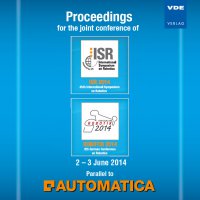Contact-State Recognition of Compliant Motion Robots Using Expectation Maximization-Based Gaussian Mixtures
Konferenz: ISR/Robotik 2014 - 45th International Symposium on Robotics; 8th German Conference on Robotics
02.06.2014 - 03.06.2014 in München, Germany
Tagungsband: ISR/Robotik 2014
Seiten: 8Sprache: EnglischTyp: PDF
Persönliche VDE-Mitglieder erhalten auf diesen Artikel 10% Rabatt
Autoren:
Jasim, Ibrahim F.; Plapper, Peter W. (Faculty of Science, Technology, and Communication, University of Luxembourg, Luxembourg)
Inhalt:
In this article, we address the problem of Contact-State (CS) recognition for force-controlled robotic tasks. At first, the wrench (Cartesian forces and torques) and pose (Cartesian position and orientation) signals of the manipulated object, in different Contact Formations (CFs) of a task, are collected. Then in the framework of the Bayesian classification, the Expectation Maximization-based Gaussian Mixtures Model (EM-GMM) is used in building efficient CFs classifiers. The use of the EM-GMM in developing the captured signals models accommodates possible signals non-stationarity, i.e. signals abnormal distribution, and enhanced recognition performance would be resulted. Experiments are performed on a KUKA Lightweight Robot (LWR) doing the cube-in-corner assembly task, which is a rigid cube object interacting with an environment composed of three orthogonal planes, and different CFs are considered. From the experimental results, the EM-GMM is shown to have an excellent recognition performance with an enhanced computational time. In order to compare the EM-GMM with the available CF recognition schemes, we developed the corresponding CF classifiers using the Gravitational Search-Fuzzy Clustering Algorithm (GS-FCA), Stochastic Gradient Boosting (SGB), and the Conventional Fuzzy Classifier(CFC) approaches. From the comparison, the EM-GMM scheme is shown to be outperforming the rest.


